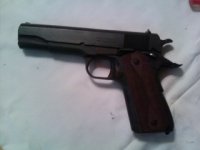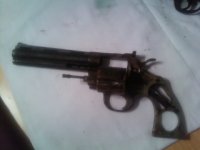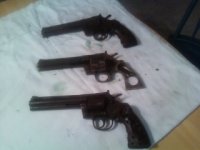Hey guys love the site!
Couple months ago my fathers home burned to the ground ,along with almost every firearm we owned.All tucked away in a safe. Needless to say a few hour fire rating is mostly useless if no one reports the fire. among the dearly departed where three pythons, one blue,one stainless,and one nickle. They were my baby girls,all virgins never shot and still in the box. and a 1943 remington rand m1911A1
We were not allowed to retrieve anything untill the insurance and state finished thier investigation. Upon whitch time I promply retrieved these 4 weapons. I went to work on the !1911 first soaking it in a pentrating oil then disassembling it. after ordering almost all new parts and having the slide and frame checked out,bead blasted and reblued, It looks great and works fine.
BUT this gun is a toy compared to these pythons. So my question is this. Can they be restored? If so where should I start? What can I do to see if it is even worth the effort.
below are some pics not the best my phone is a POS.
Thanks
Couple months ago my fathers home burned to the ground ,along with almost every firearm we owned.All tucked away in a safe. Needless to say a few hour fire rating is mostly useless if no one reports the fire. among the dearly departed where three pythons, one blue,one stainless,and one nickle. They were my baby girls,all virgins never shot and still in the box. and a 1943 remington rand m1911A1
We were not allowed to retrieve anything untill the insurance and state finished thier investigation. Upon whitch time I promply retrieved these 4 weapons. I went to work on the !1911 first soaking it in a pentrating oil then disassembling it. after ordering almost all new parts and having the slide and frame checked out,bead blasted and reblued, It looks great and works fine.
BUT this gun is a toy compared to these pythons. So my question is this. Can they be restored? If so where should I start? What can I do to see if it is even worth the effort.
below are some pics not the best my phone is a POS.
Thanks



